Strategic Management Report: Vodafone's External and Internal Analysis
VerifiedAdded on 2023/01/18
|18
|5080
|70
Report
AI Summary
This report provides a strategic management analysis of Vodafone, examining its external environment and market conditions through a PESTLE analysis, which covers political, economic, social, technological, legal, and environmental factors. It also utilizes Porter's Five Forces model to assess the competitive landscape. The internal analysis employs SWOT and VRIO frameworks to evaluate Vodafone's strengths, weaknesses, opportunities, and threats, as well as its resources and capabilities. The report further discusses potential strategies for Vodafone to defend its core business and achieve its objectives. The analysis considers the telecommunications industry's challenges and opportunities, providing insights into Vodafone's strategic positioning and future prospects. The report concludes with a summary of the key findings and recommendations for Vodafone's strategic direction.
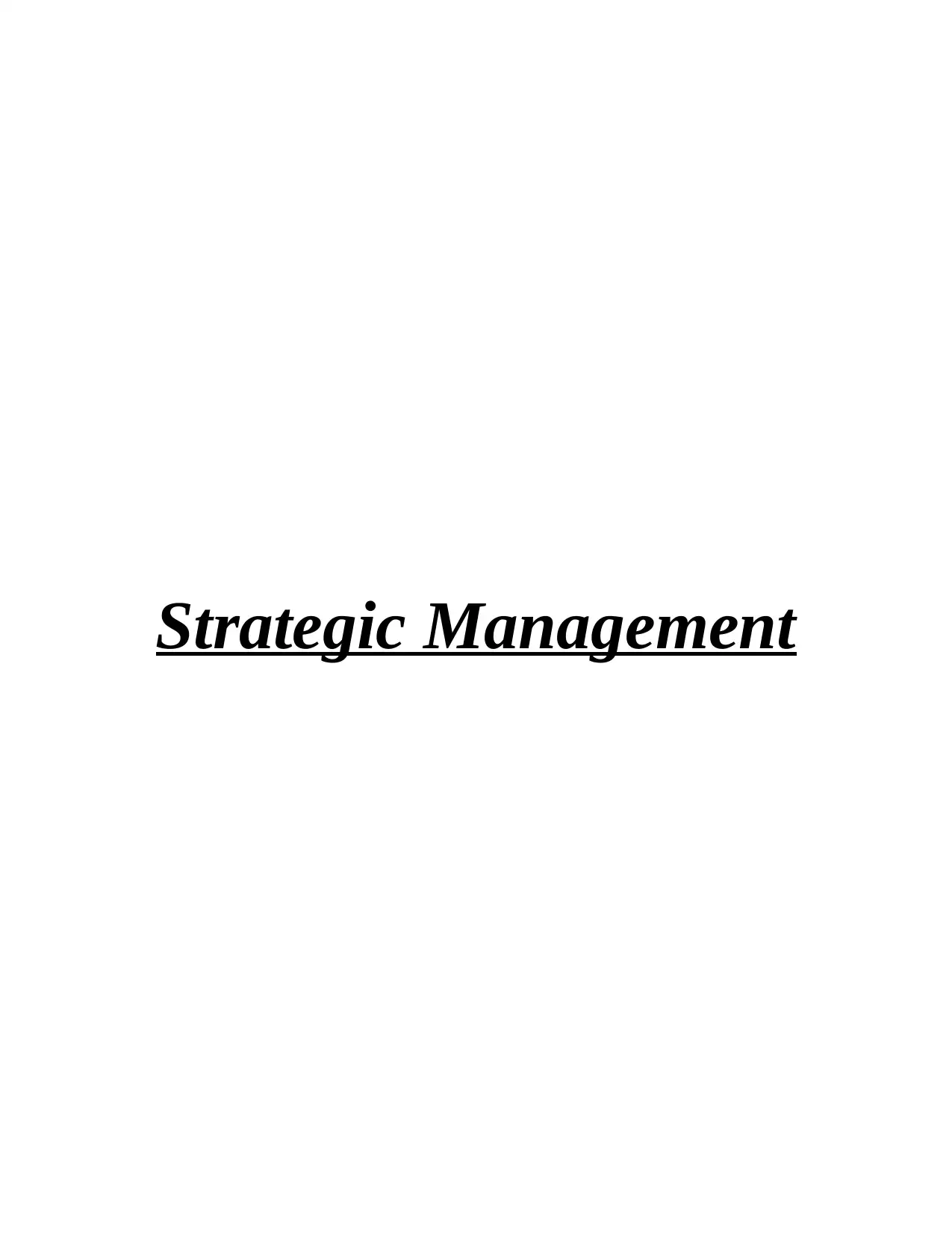
Strategic Management
Paraphrase This Document
Need a fresh take? Get an instant paraphrase of this document with our AI Paraphraser

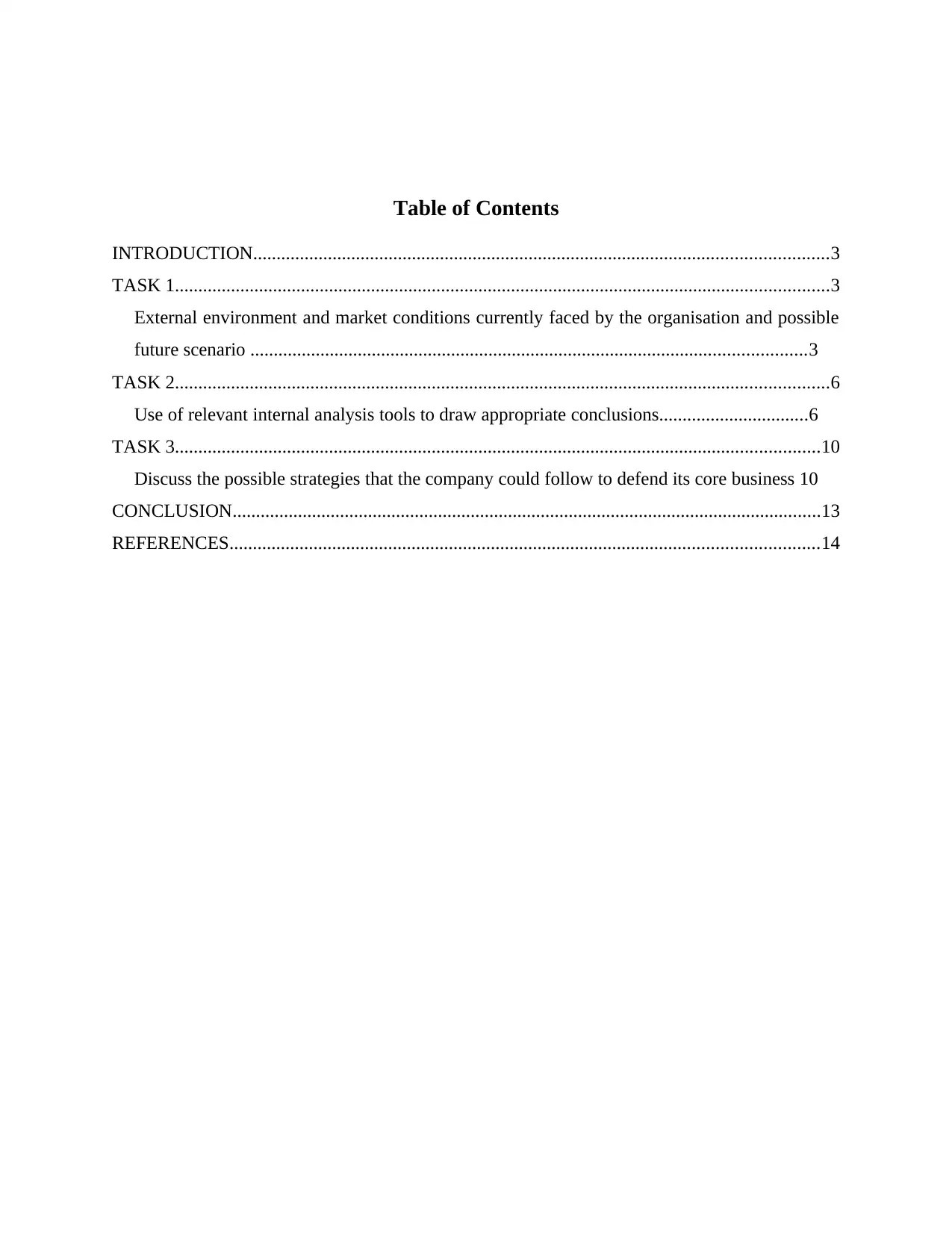
Table of Contents
INTRODUCTION...........................................................................................................................3
TASK 1............................................................................................................................................3
External environment and market conditions currently faced by the organisation and possible
future scenario .......................................................................................................................3
TASK 2............................................................................................................................................6
Use of relevant internal analysis tools to draw appropriate conclusions................................6
TASK 3..........................................................................................................................................10
Discuss the possible strategies that the company could follow to defend its core business 10
CONCLUSION..............................................................................................................................13
REFERENCES..............................................................................................................................14
INTRODUCTION...........................................................................................................................3
TASK 1............................................................................................................................................3
External environment and market conditions currently faced by the organisation and possible
future scenario .......................................................................................................................3
TASK 2............................................................................................................................................6
Use of relevant internal analysis tools to draw appropriate conclusions................................6
TASK 3..........................................................................................................................................10
Discuss the possible strategies that the company could follow to defend its core business 10
CONCLUSION..............................................................................................................................13
REFERENCES..............................................................................................................................14
⊘ This is a preview!⊘
Do you want full access?
Subscribe today to unlock all pages.

Trusted by 1+ million students worldwide
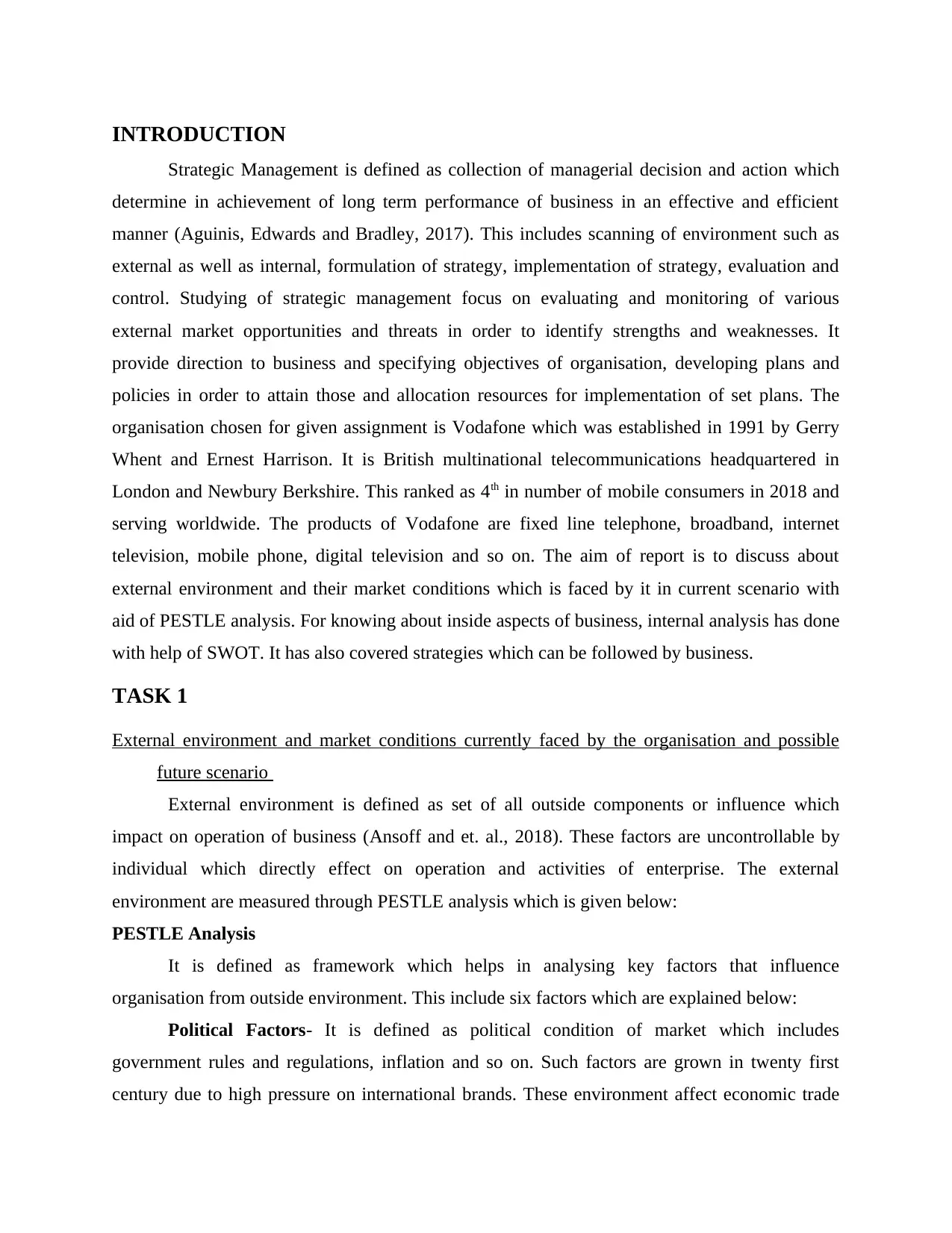
INTRODUCTION
Strategic Management is defined as collection of managerial decision and action which
determine in achievement of long term performance of business in an effective and efficient
manner (Aguinis, Edwards and Bradley, 2017). This includes scanning of environment such as
external as well as internal, formulation of strategy, implementation of strategy, evaluation and
control. Studying of strategic management focus on evaluating and monitoring of various
external market opportunities and threats in order to identify strengths and weaknesses. It
provide direction to business and specifying objectives of organisation, developing plans and
policies in order to attain those and allocation resources for implementation of set plans. The
organisation chosen for given assignment is Vodafone which was established in 1991 by Gerry
Whent and Ernest Harrison. It is British multinational telecommunications headquartered in
London and Newbury Berkshire. This ranked as 4th in number of mobile consumers in 2018 and
serving worldwide. The products of Vodafone are fixed line telephone, broadband, internet
television, mobile phone, digital television and so on. The aim of report is to discuss about
external environment and their market conditions which is faced by it in current scenario with
aid of PESTLE analysis. For knowing about inside aspects of business, internal analysis has done
with help of SWOT. It has also covered strategies which can be followed by business.
TASK 1
External environment and market conditions currently faced by the organisation and possible
future scenario
External environment is defined as set of all outside components or influence which
impact on operation of business (Ansoff and et. al., 2018). These factors are uncontrollable by
individual which directly effect on operation and activities of enterprise. The external
environment are measured through PESTLE analysis which is given below:
PESTLE Analysis
It is defined as framework which helps in analysing key factors that influence
organisation from outside environment. This include six factors which are explained below:
Political Factors- It is defined as political condition of market which includes
government rules and regulations, inflation and so on. Such factors are grown in twenty first
century due to high pressure on international brands. These environment affect economic trade
Strategic Management is defined as collection of managerial decision and action which
determine in achievement of long term performance of business in an effective and efficient
manner (Aguinis, Edwards and Bradley, 2017). This includes scanning of environment such as
external as well as internal, formulation of strategy, implementation of strategy, evaluation and
control. Studying of strategic management focus on evaluating and monitoring of various
external market opportunities and threats in order to identify strengths and weaknesses. It
provide direction to business and specifying objectives of organisation, developing plans and
policies in order to attain those and allocation resources for implementation of set plans. The
organisation chosen for given assignment is Vodafone which was established in 1991 by Gerry
Whent and Ernest Harrison. It is British multinational telecommunications headquartered in
London and Newbury Berkshire. This ranked as 4th in number of mobile consumers in 2018 and
serving worldwide. The products of Vodafone are fixed line telephone, broadband, internet
television, mobile phone, digital television and so on. The aim of report is to discuss about
external environment and their market conditions which is faced by it in current scenario with
aid of PESTLE analysis. For knowing about inside aspects of business, internal analysis has done
with help of SWOT. It has also covered strategies which can be followed by business.
TASK 1
External environment and market conditions currently faced by the organisation and possible
future scenario
External environment is defined as set of all outside components or influence which
impact on operation of business (Ansoff and et. al., 2018). These factors are uncontrollable by
individual which directly effect on operation and activities of enterprise. The external
environment are measured through PESTLE analysis which is given below:
PESTLE Analysis
It is defined as framework which helps in analysing key factors that influence
organisation from outside environment. This include six factors which are explained below:
Political Factors- It is defined as political condition of market which includes
government rules and regulations, inflation and so on. Such factors are grown in twenty first
century due to high pressure on international brands. These environment affect economic trade
Paraphrase This Document
Need a fresh take? Get an instant paraphrase of this document with our AI Paraphraser
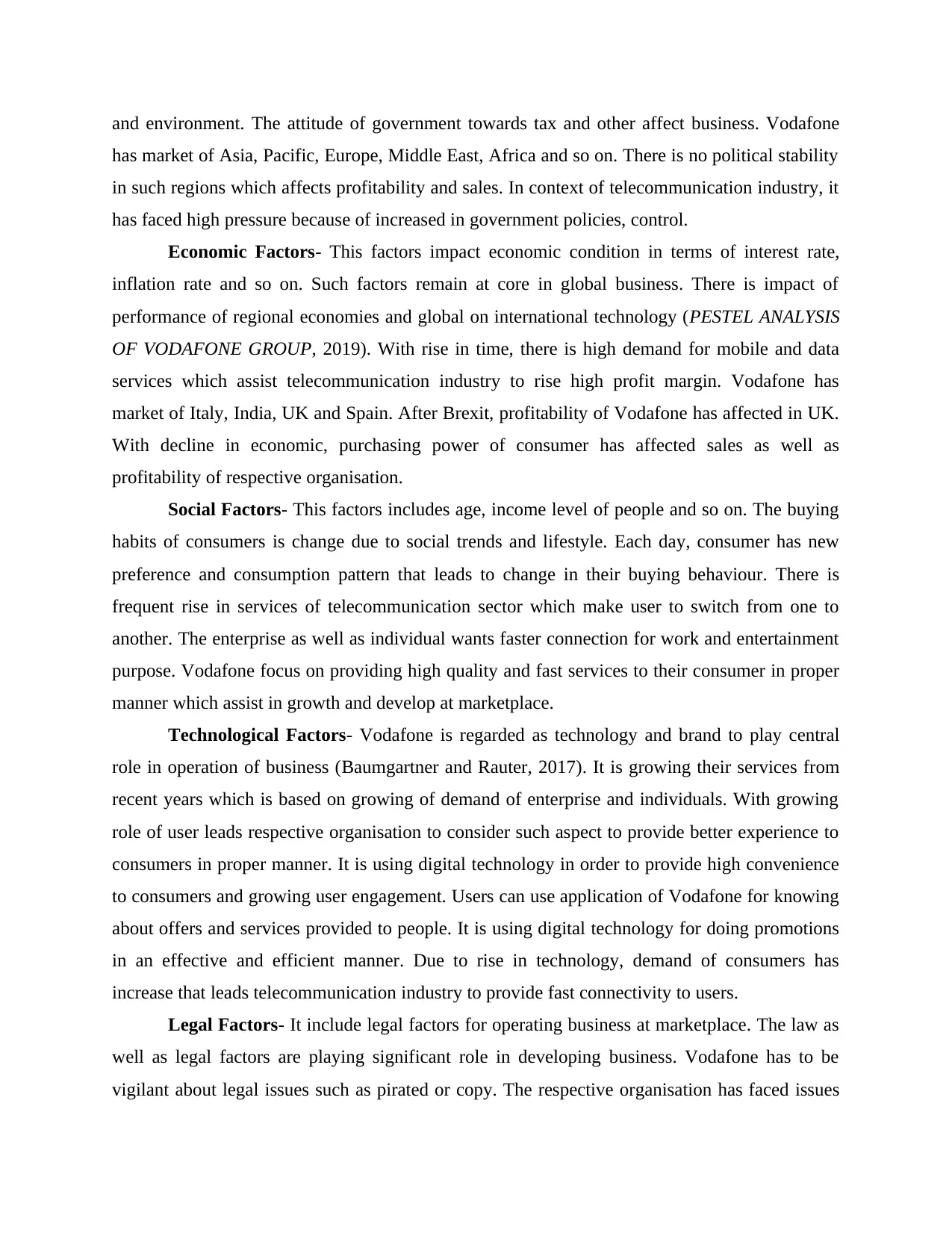
and environment. The attitude of government towards tax and other affect business. Vodafone
has market of Asia, Pacific, Europe, Middle East, Africa and so on. There is no political stability
in such regions which affects profitability and sales. In context of telecommunication industry, it
has faced high pressure because of increased in government policies, control.
Economic Factors- This factors impact economic condition in terms of interest rate,
inflation rate and so on. Such factors remain at core in global business. There is impact of
performance of regional economies and global on international technology (PESTEL ANALYSIS
OF VODAFONE GROUP, 2019). With rise in time, there is high demand for mobile and data
services which assist telecommunication industry to rise high profit margin. Vodafone has
market of Italy, India, UK and Spain. After Brexit, profitability of Vodafone has affected in UK.
With decline in economic, purchasing power of consumer has affected sales as well as
profitability of respective organisation.
Social Factors- This factors includes age, income level of people and so on. The buying
habits of consumers is change due to social trends and lifestyle. Each day, consumer has new
preference and consumption pattern that leads to change in their buying behaviour. There is
frequent rise in services of telecommunication sector which make user to switch from one to
another. The enterprise as well as individual wants faster connection for work and entertainment
purpose. Vodafone focus on providing high quality and fast services to their consumer in proper
manner which assist in growth and develop at marketplace.
Technological Factors- Vodafone is regarded as technology and brand to play central
role in operation of business (Baumgartner and Rauter, 2017). It is growing their services from
recent years which is based on growing of demand of enterprise and individuals. With growing
role of user leads respective organisation to consider such aspect to provide better experience to
consumers in proper manner. It is using digital technology in order to provide high convenience
to consumers and growing user engagement. Users can use application of Vodafone for knowing
about offers and services provided to people. It is using digital technology for doing promotions
in an effective and efficient manner. Due to rise in technology, demand of consumers has
increase that leads telecommunication industry to provide fast connectivity to users.
Legal Factors- It include legal factors for operating business at marketplace. The law as
well as legal factors are playing significant role in developing business. Vodafone has to be
vigilant about legal issues such as pirated or copy. The respective organisation has faced issues
has market of Asia, Pacific, Europe, Middle East, Africa and so on. There is no political stability
in such regions which affects profitability and sales. In context of telecommunication industry, it
has faced high pressure because of increased in government policies, control.
Economic Factors- This factors impact economic condition in terms of interest rate,
inflation rate and so on. Such factors remain at core in global business. There is impact of
performance of regional economies and global on international technology (PESTEL ANALYSIS
OF VODAFONE GROUP, 2019). With rise in time, there is high demand for mobile and data
services which assist telecommunication industry to rise high profit margin. Vodafone has
market of Italy, India, UK and Spain. After Brexit, profitability of Vodafone has affected in UK.
With decline in economic, purchasing power of consumer has affected sales as well as
profitability of respective organisation.
Social Factors- This factors includes age, income level of people and so on. The buying
habits of consumers is change due to social trends and lifestyle. Each day, consumer has new
preference and consumption pattern that leads to change in their buying behaviour. There is
frequent rise in services of telecommunication sector which make user to switch from one to
another. The enterprise as well as individual wants faster connection for work and entertainment
purpose. Vodafone focus on providing high quality and fast services to their consumer in proper
manner which assist in growth and develop at marketplace.
Technological Factors- Vodafone is regarded as technology and brand to play central
role in operation of business (Baumgartner and Rauter, 2017). It is growing their services from
recent years which is based on growing of demand of enterprise and individuals. With growing
role of user leads respective organisation to consider such aspect to provide better experience to
consumers in proper manner. It is using digital technology in order to provide high convenience
to consumers and growing user engagement. Users can use application of Vodafone for knowing
about offers and services provided to people. It is using digital technology for doing promotions
in an effective and efficient manner. Due to rise in technology, demand of consumers has
increase that leads telecommunication industry to provide fast connectivity to users.
Legal Factors- It include legal factors for operating business at marketplace. The law as
well as legal factors are playing significant role in developing business. Vodafone has to be
vigilant about legal issues such as pirated or copy. The respective organisation has faced issues
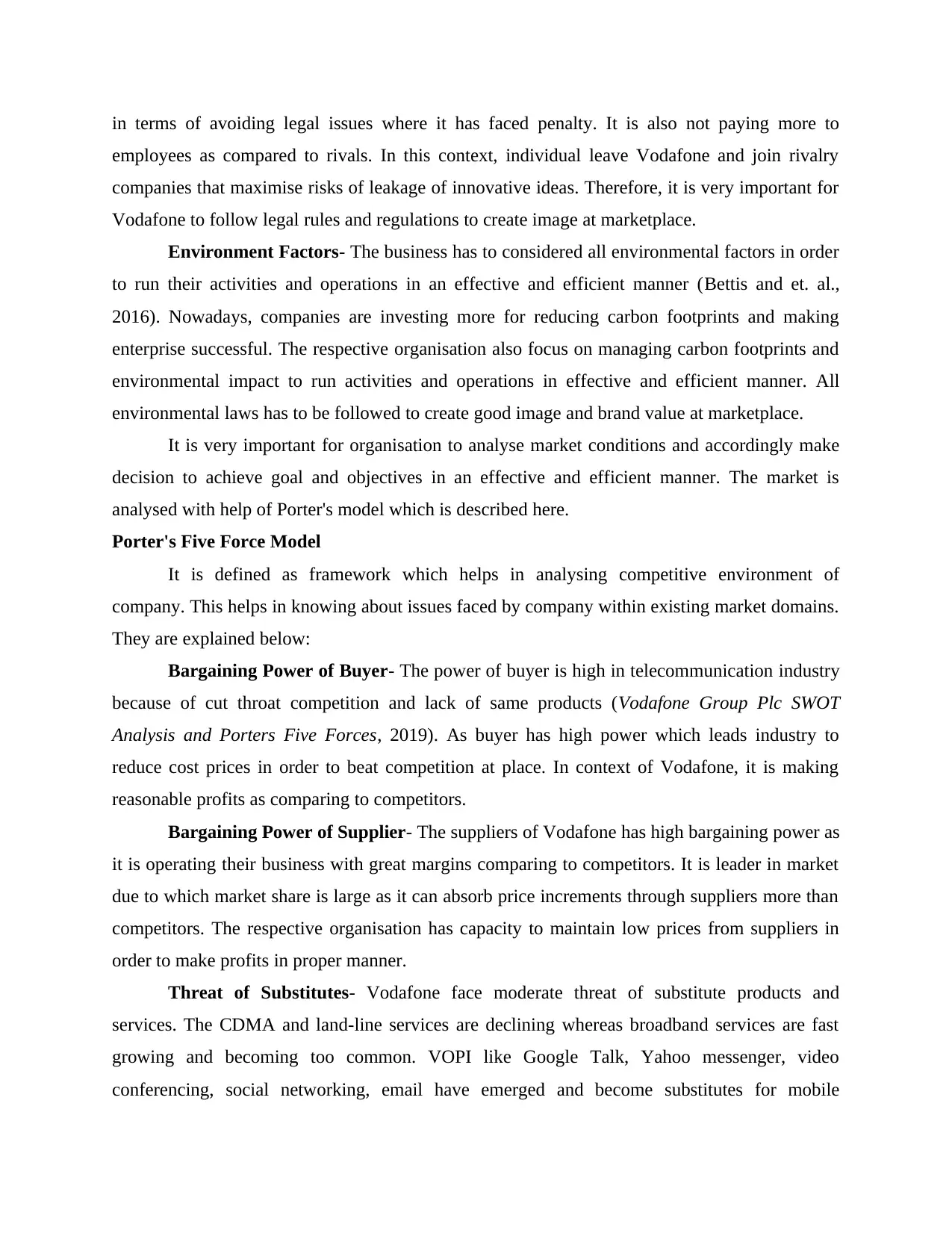
in terms of avoiding legal issues where it has faced penalty. It is also not paying more to
employees as compared to rivals. In this context, individual leave Vodafone and join rivalry
companies that maximise risks of leakage of innovative ideas. Therefore, it is very important for
Vodafone to follow legal rules and regulations to create image at marketplace.
Environment Factors- The business has to considered all environmental factors in order
to run their activities and operations in an effective and efficient manner (Bettis and et. al.,
2016). Nowadays, companies are investing more for reducing carbon footprints and making
enterprise successful. The respective organisation also focus on managing carbon footprints and
environmental impact to run activities and operations in effective and efficient manner. All
environmental laws has to be followed to create good image and brand value at marketplace.
It is very important for organisation to analyse market conditions and accordingly make
decision to achieve goal and objectives in an effective and efficient manner. The market is
analysed with help of Porter's model which is described here.
Porter's Five Force Model
It is defined as framework which helps in analysing competitive environment of
company. This helps in knowing about issues faced by company within existing market domains.
They are explained below:
Bargaining Power of Buyer- The power of buyer is high in telecommunication industry
because of cut throat competition and lack of same products (Vodafone Group Plc SWOT
Analysis and Porters Five Forces, 2019). As buyer has high power which leads industry to
reduce cost prices in order to beat competition at place. In context of Vodafone, it is making
reasonable profits as comparing to competitors.
Bargaining Power of Supplier- The suppliers of Vodafone has high bargaining power as
it is operating their business with great margins comparing to competitors. It is leader in market
due to which market share is large as it can absorb price increments through suppliers more than
competitors. The respective organisation has capacity to maintain low prices from suppliers in
order to make profits in proper manner.
Threat of Substitutes- Vodafone face moderate threat of substitute products and
services. The CDMA and land-line services are declining whereas broadband services are fast
growing and becoming too common. VOPI like Google Talk, Yahoo messenger, video
conferencing, social networking, email have emerged and become substitutes for mobile
employees as compared to rivals. In this context, individual leave Vodafone and join rivalry
companies that maximise risks of leakage of innovative ideas. Therefore, it is very important for
Vodafone to follow legal rules and regulations to create image at marketplace.
Environment Factors- The business has to considered all environmental factors in order
to run their activities and operations in an effective and efficient manner (Bettis and et. al.,
2016). Nowadays, companies are investing more for reducing carbon footprints and making
enterprise successful. The respective organisation also focus on managing carbon footprints and
environmental impact to run activities and operations in effective and efficient manner. All
environmental laws has to be followed to create good image and brand value at marketplace.
It is very important for organisation to analyse market conditions and accordingly make
decision to achieve goal and objectives in an effective and efficient manner. The market is
analysed with help of Porter's model which is described here.
Porter's Five Force Model
It is defined as framework which helps in analysing competitive environment of
company. This helps in knowing about issues faced by company within existing market domains.
They are explained below:
Bargaining Power of Buyer- The power of buyer is high in telecommunication industry
because of cut throat competition and lack of same products (Vodafone Group Plc SWOT
Analysis and Porters Five Forces, 2019). As buyer has high power which leads industry to
reduce cost prices in order to beat competition at place. In context of Vodafone, it is making
reasonable profits as comparing to competitors.
Bargaining Power of Supplier- The suppliers of Vodafone has high bargaining power as
it is operating their business with great margins comparing to competitors. It is leader in market
due to which market share is large as it can absorb price increments through suppliers more than
competitors. The respective organisation has capacity to maintain low prices from suppliers in
order to make profits in proper manner.
Threat of Substitutes- Vodafone face moderate threat of substitute products and
services. The CDMA and land-line services are declining whereas broadband services are fast
growing and becoming too common. VOPI like Google Talk, Yahoo messenger, video
conferencing, social networking, email have emerged and become substitutes for mobile
⊘ This is a preview!⊘
Do you want full access?
Subscribe today to unlock all pages.

Trusted by 1+ million students worldwide
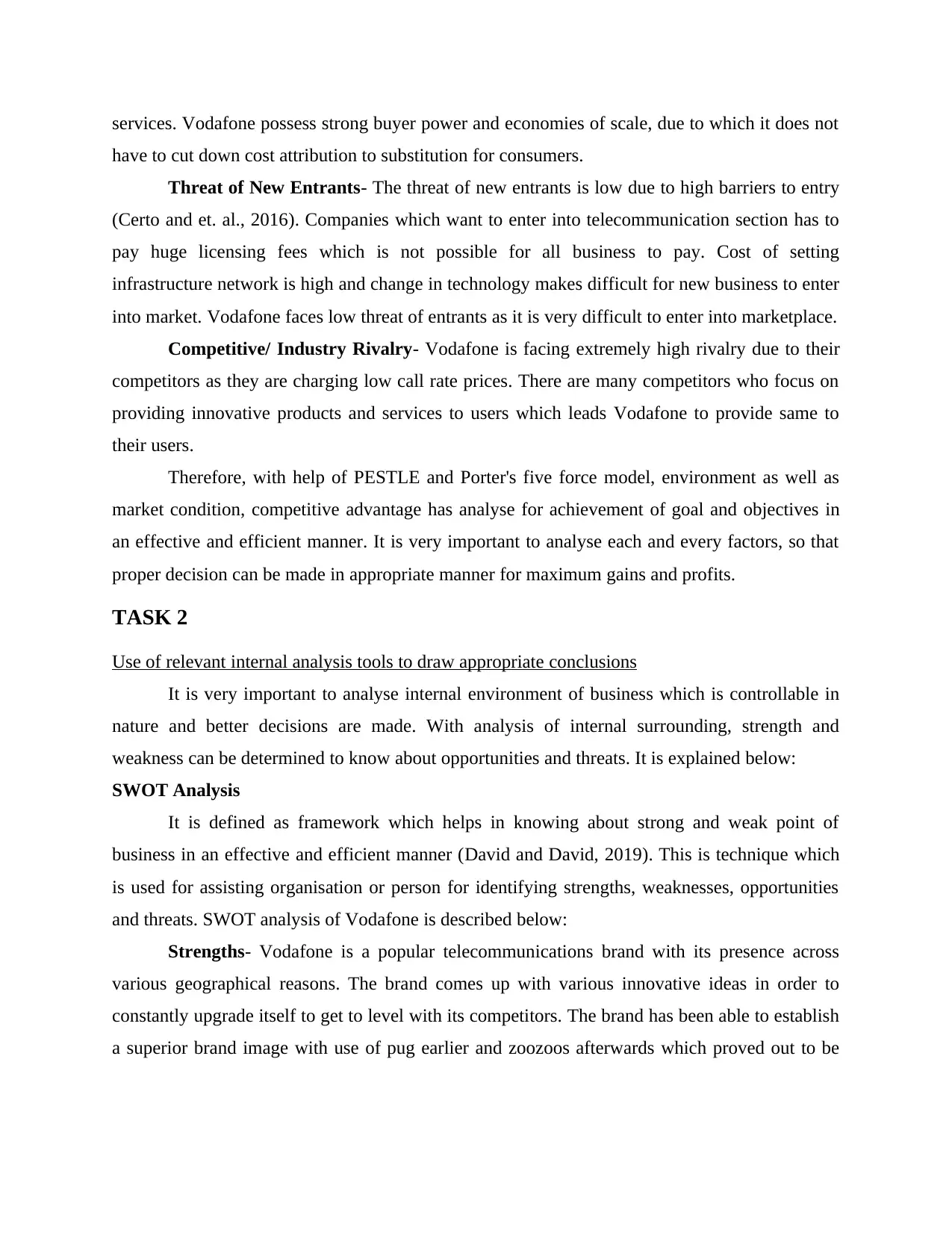
services. Vodafone possess strong buyer power and economies of scale, due to which it does not
have to cut down cost attribution to substitution for consumers.
Threat of New Entrants- The threat of new entrants is low due to high barriers to entry
(Certo and et. al., 2016). Companies which want to enter into telecommunication section has to
pay huge licensing fees which is not possible for all business to pay. Cost of setting
infrastructure network is high and change in technology makes difficult for new business to enter
into market. Vodafone faces low threat of entrants as it is very difficult to enter into marketplace.
Competitive/ Industry Rivalry- Vodafone is facing extremely high rivalry due to their
competitors as they are charging low call rate prices. There are many competitors who focus on
providing innovative products and services to users which leads Vodafone to provide same to
their users.
Therefore, with help of PESTLE and Porter's five force model, environment as well as
market condition, competitive advantage has analyse for achievement of goal and objectives in
an effective and efficient manner. It is very important to analyse each and every factors, so that
proper decision can be made in appropriate manner for maximum gains and profits.
TASK 2
Use of relevant internal analysis tools to draw appropriate conclusions
It is very important to analyse internal environment of business which is controllable in
nature and better decisions are made. With analysis of internal surrounding, strength and
weakness can be determined to know about opportunities and threats. It is explained below:
SWOT Analysis
It is defined as framework which helps in knowing about strong and weak point of
business in an effective and efficient manner (David and David, 2019). This is technique which
is used for assisting organisation or person for identifying strengths, weaknesses, opportunities
and threats. SWOT analysis of Vodafone is described below:
Strengths- Vodafone is a popular telecommunications brand with its presence across
various geographical reasons. The brand comes up with various innovative ideas in order to
constantly upgrade itself to get to level with its competitors. The brand has been able to establish
a superior brand image with use of pug earlier and zoozoos afterwards which proved out to be
have to cut down cost attribution to substitution for consumers.
Threat of New Entrants- The threat of new entrants is low due to high barriers to entry
(Certo and et. al., 2016). Companies which want to enter into telecommunication section has to
pay huge licensing fees which is not possible for all business to pay. Cost of setting
infrastructure network is high and change in technology makes difficult for new business to enter
into market. Vodafone faces low threat of entrants as it is very difficult to enter into marketplace.
Competitive/ Industry Rivalry- Vodafone is facing extremely high rivalry due to their
competitors as they are charging low call rate prices. There are many competitors who focus on
providing innovative products and services to users which leads Vodafone to provide same to
their users.
Therefore, with help of PESTLE and Porter's five force model, environment as well as
market condition, competitive advantage has analyse for achievement of goal and objectives in
an effective and efficient manner. It is very important to analyse each and every factors, so that
proper decision can be made in appropriate manner for maximum gains and profits.
TASK 2
Use of relevant internal analysis tools to draw appropriate conclusions
It is very important to analyse internal environment of business which is controllable in
nature and better decisions are made. With analysis of internal surrounding, strength and
weakness can be determined to know about opportunities and threats. It is explained below:
SWOT Analysis
It is defined as framework which helps in knowing about strong and weak point of
business in an effective and efficient manner (David and David, 2019). This is technique which
is used for assisting organisation or person for identifying strengths, weaknesses, opportunities
and threats. SWOT analysis of Vodafone is described below:
Strengths- Vodafone is a popular telecommunications brand with its presence across
various geographical reasons. The brand comes up with various innovative ideas in order to
constantly upgrade itself to get to level with its competitors. The brand has been able to establish
a superior brand image with use of pug earlier and zoozoos afterwards which proved out to be
Paraphrase This Document
Need a fresh take? Get an instant paraphrase of this document with our AI Paraphraser
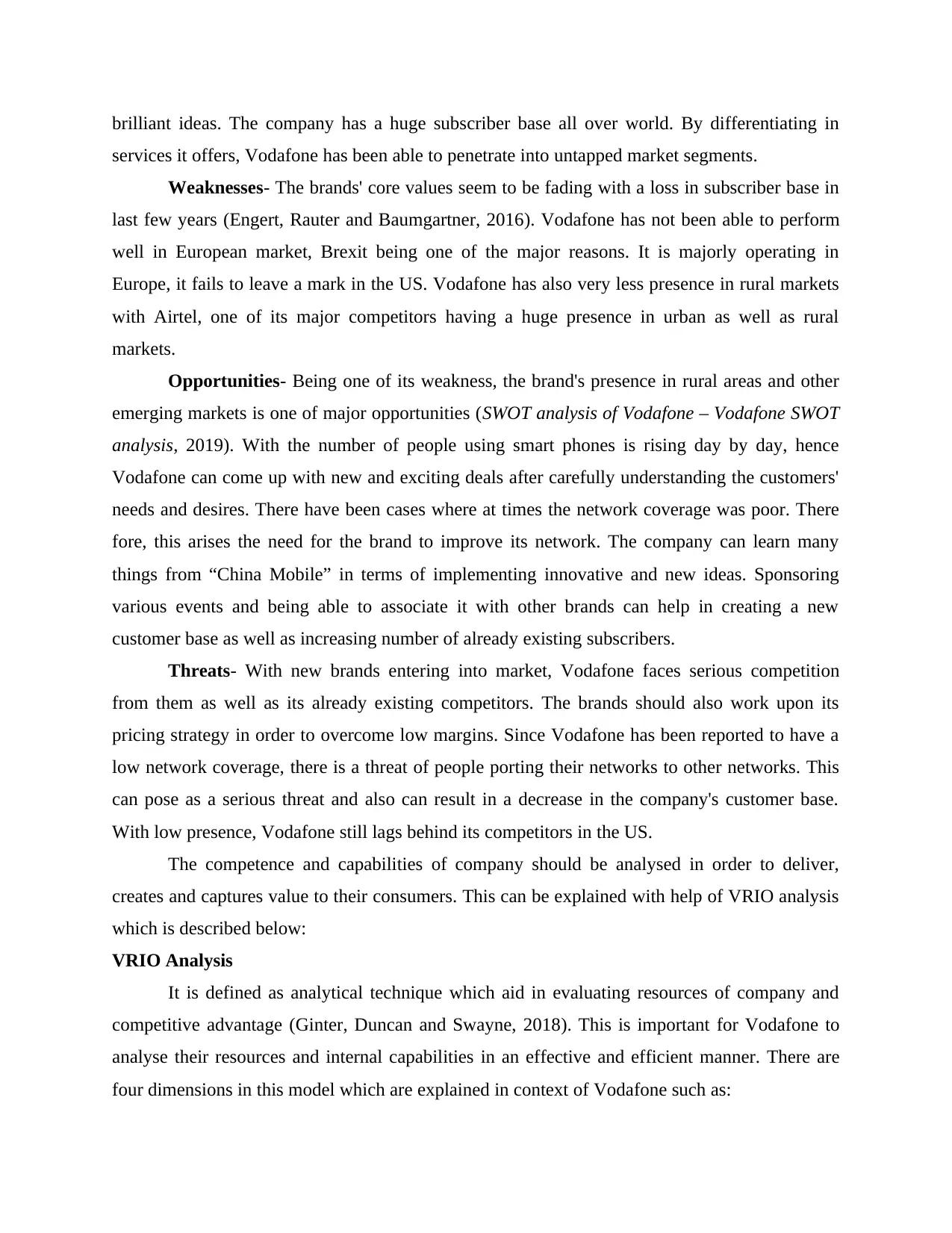
brilliant ideas. The company has a huge subscriber base all over world. By differentiating in
services it offers, Vodafone has been able to penetrate into untapped market segments.
Weaknesses- The brands' core values seem to be fading with a loss in subscriber base in
last few years (Engert, Rauter and Baumgartner, 2016). Vodafone has not been able to perform
well in European market, Brexit being one of the major reasons. It is majorly operating in
Europe, it fails to leave a mark in the US. Vodafone has also very less presence in rural markets
with Airtel, one of its major competitors having a huge presence in urban as well as rural
markets.
Opportunities- Being one of its weakness, the brand's presence in rural areas and other
emerging markets is one of major opportunities (SWOT analysis of Vodafone – Vodafone SWOT
analysis, 2019). With the number of people using smart phones is rising day by day, hence
Vodafone can come up with new and exciting deals after carefully understanding the customers'
needs and desires. There have been cases where at times the network coverage was poor. There
fore, this arises the need for the brand to improve its network. The company can learn many
things from “China Mobile” in terms of implementing innovative and new ideas. Sponsoring
various events and being able to associate it with other brands can help in creating a new
customer base as well as increasing number of already existing subscribers.
Threats- With new brands entering into market, Vodafone faces serious competition
from them as well as its already existing competitors. The brands should also work upon its
pricing strategy in order to overcome low margins. Since Vodafone has been reported to have a
low network coverage, there is a threat of people porting their networks to other networks. This
can pose as a serious threat and also can result in a decrease in the company's customer base.
With low presence, Vodafone still lags behind its competitors in the US.
The competence and capabilities of company should be analysed in order to deliver,
creates and captures value to their consumers. This can be explained with help of VRIO analysis
which is described below:
VRIO Analysis
It is defined as analytical technique which aid in evaluating resources of company and
competitive advantage (Ginter, Duncan and Swayne, 2018). This is important for Vodafone to
analyse their resources and internal capabilities in an effective and efficient manner. There are
four dimensions in this model which are explained in context of Vodafone such as:
services it offers, Vodafone has been able to penetrate into untapped market segments.
Weaknesses- The brands' core values seem to be fading with a loss in subscriber base in
last few years (Engert, Rauter and Baumgartner, 2016). Vodafone has not been able to perform
well in European market, Brexit being one of the major reasons. It is majorly operating in
Europe, it fails to leave a mark in the US. Vodafone has also very less presence in rural markets
with Airtel, one of its major competitors having a huge presence in urban as well as rural
markets.
Opportunities- Being one of its weakness, the brand's presence in rural areas and other
emerging markets is one of major opportunities (SWOT analysis of Vodafone – Vodafone SWOT
analysis, 2019). With the number of people using smart phones is rising day by day, hence
Vodafone can come up with new and exciting deals after carefully understanding the customers'
needs and desires. There have been cases where at times the network coverage was poor. There
fore, this arises the need for the brand to improve its network. The company can learn many
things from “China Mobile” in terms of implementing innovative and new ideas. Sponsoring
various events and being able to associate it with other brands can help in creating a new
customer base as well as increasing number of already existing subscribers.
Threats- With new brands entering into market, Vodafone faces serious competition
from them as well as its already existing competitors. The brands should also work upon its
pricing strategy in order to overcome low margins. Since Vodafone has been reported to have a
low network coverage, there is a threat of people porting their networks to other networks. This
can pose as a serious threat and also can result in a decrease in the company's customer base.
With low presence, Vodafone still lags behind its competitors in the US.
The competence and capabilities of company should be analysed in order to deliver,
creates and captures value to their consumers. This can be explained with help of VRIO analysis
which is described below:
VRIO Analysis
It is defined as analytical technique which aid in evaluating resources of company and
competitive advantage (Ginter, Duncan and Swayne, 2018). This is important for Vodafone to
analyse their resources and internal capabilities in an effective and efficient manner. There are
four dimensions in this model which are explained in context of Vodafone such as:
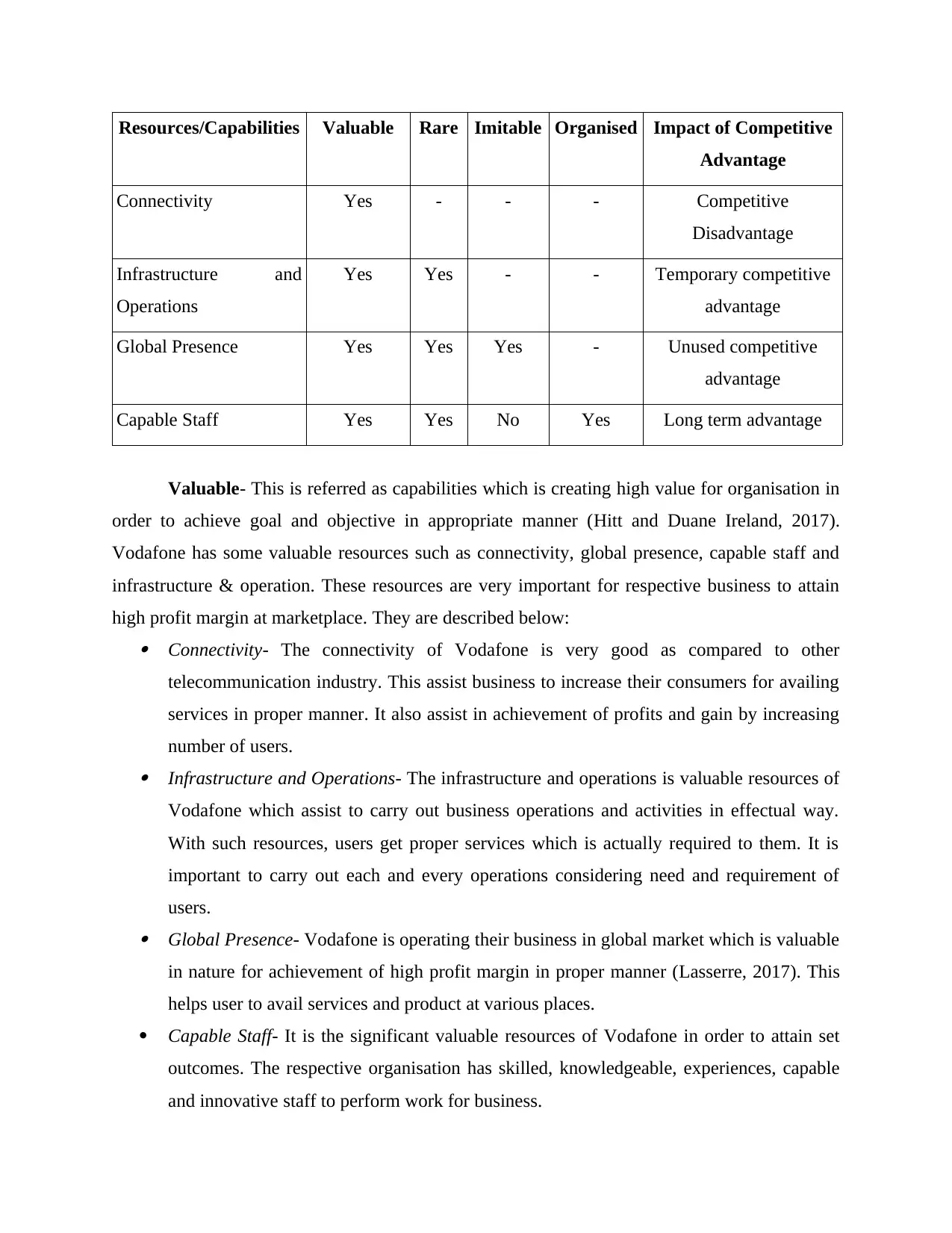
Resources/Capabilities Valuable Rare Imitable Organised Impact of Competitive
Advantage
Connectivity Yes - - - Competitive
Disadvantage
Infrastructure and
Operations
Yes Yes - - Temporary competitive
advantage
Global Presence Yes Yes Yes - Unused competitive
advantage
Capable Staff Yes Yes No Yes Long term advantage
Valuable- This is referred as capabilities which is creating high value for organisation in
order to achieve goal and objective in appropriate manner (Hitt and Duane Ireland, 2017).
Vodafone has some valuable resources such as connectivity, global presence, capable staff and
infrastructure & operation. These resources are very important for respective business to attain
high profit margin at marketplace. They are described below: Connectivity- The connectivity of Vodafone is very good as compared to other
telecommunication industry. This assist business to increase their consumers for availing
services in proper manner. It also assist in achievement of profits and gain by increasing
number of users. Infrastructure and Operations- The infrastructure and operations is valuable resources of
Vodafone which assist to carry out business operations and activities in effectual way.
With such resources, users get proper services which is actually required to them. It is
important to carry out each and every operations considering need and requirement of
users. Global Presence- Vodafone is operating their business in global market which is valuable
in nature for achievement of high profit margin in proper manner (Lasserre, 2017). This
helps user to avail services and product at various places.
Capable Staff- It is the significant valuable resources of Vodafone in order to attain set
outcomes. The respective organisation has skilled, knowledgeable, experiences, capable
and innovative staff to perform work for business.
Advantage
Connectivity Yes - - - Competitive
Disadvantage
Infrastructure and
Operations
Yes Yes - - Temporary competitive
advantage
Global Presence Yes Yes Yes - Unused competitive
advantage
Capable Staff Yes Yes No Yes Long term advantage
Valuable- This is referred as capabilities which is creating high value for organisation in
order to achieve goal and objective in appropriate manner (Hitt and Duane Ireland, 2017).
Vodafone has some valuable resources such as connectivity, global presence, capable staff and
infrastructure & operation. These resources are very important for respective business to attain
high profit margin at marketplace. They are described below: Connectivity- The connectivity of Vodafone is very good as compared to other
telecommunication industry. This assist business to increase their consumers for availing
services in proper manner. It also assist in achievement of profits and gain by increasing
number of users. Infrastructure and Operations- The infrastructure and operations is valuable resources of
Vodafone which assist to carry out business operations and activities in effectual way.
With such resources, users get proper services which is actually required to them. It is
important to carry out each and every operations considering need and requirement of
users. Global Presence- Vodafone is operating their business in global market which is valuable
in nature for achievement of high profit margin in proper manner (Lasserre, 2017). This
helps user to avail services and product at various places.
Capable Staff- It is the significant valuable resources of Vodafone in order to attain set
outcomes. The respective organisation has skilled, knowledgeable, experiences, capable
and innovative staff to perform work for business.
⊘ This is a preview!⊘
Do you want full access?
Subscribe today to unlock all pages.

Trusted by 1+ million students worldwide
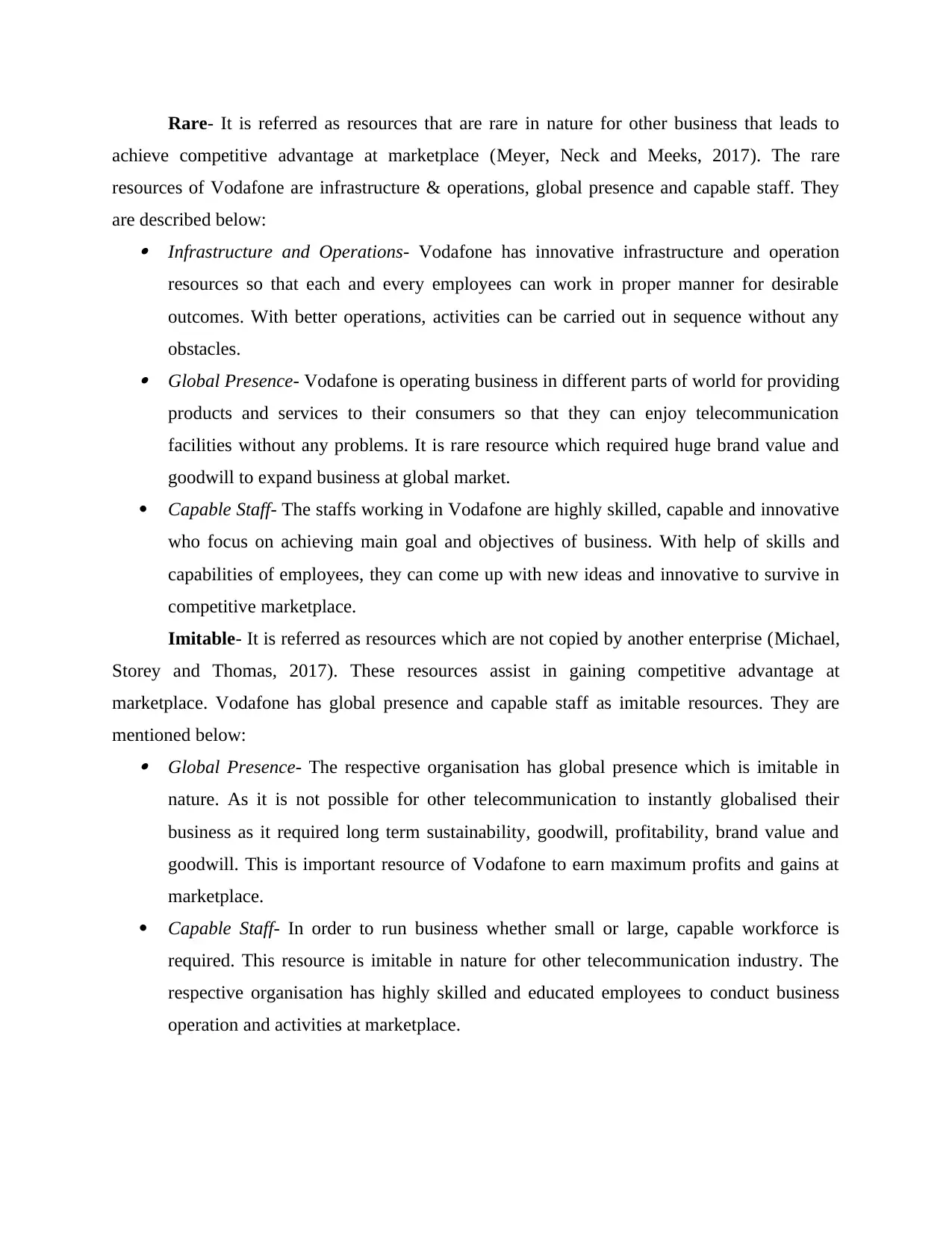
Rare- It is referred as resources that are rare in nature for other business that leads to
achieve competitive advantage at marketplace (Meyer, Neck and Meeks, 2017). The rare
resources of Vodafone are infrastructure & operations, global presence and capable staff. They
are described below: Infrastructure and Operations- Vodafone has innovative infrastructure and operation
resources so that each and every employees can work in proper manner for desirable
outcomes. With better operations, activities can be carried out in sequence without any
obstacles. Global Presence- Vodafone is operating business in different parts of world for providing
products and services to their consumers so that they can enjoy telecommunication
facilities without any problems. It is rare resource which required huge brand value and
goodwill to expand business at global market.
Capable Staff- The staffs working in Vodafone are highly skilled, capable and innovative
who focus on achieving main goal and objectives of business. With help of skills and
capabilities of employees, they can come up with new ideas and innovative to survive in
competitive marketplace.
Imitable- It is referred as resources which are not copied by another enterprise (Michael,
Storey and Thomas, 2017). These resources assist in gaining competitive advantage at
marketplace. Vodafone has global presence and capable staff as imitable resources. They are
mentioned below: Global Presence- The respective organisation has global presence which is imitable in
nature. As it is not possible for other telecommunication to instantly globalised their
business as it required long term sustainability, goodwill, profitability, brand value and
goodwill. This is important resource of Vodafone to earn maximum profits and gains at
marketplace.
Capable Staff- In order to run business whether small or large, capable workforce is
required. This resource is imitable in nature for other telecommunication industry. The
respective organisation has highly skilled and educated employees to conduct business
operation and activities at marketplace.
achieve competitive advantage at marketplace (Meyer, Neck and Meeks, 2017). The rare
resources of Vodafone are infrastructure & operations, global presence and capable staff. They
are described below: Infrastructure and Operations- Vodafone has innovative infrastructure and operation
resources so that each and every employees can work in proper manner for desirable
outcomes. With better operations, activities can be carried out in sequence without any
obstacles. Global Presence- Vodafone is operating business in different parts of world for providing
products and services to their consumers so that they can enjoy telecommunication
facilities without any problems. It is rare resource which required huge brand value and
goodwill to expand business at global market.
Capable Staff- The staffs working in Vodafone are highly skilled, capable and innovative
who focus on achieving main goal and objectives of business. With help of skills and
capabilities of employees, they can come up with new ideas and innovative to survive in
competitive marketplace.
Imitable- It is referred as resources which are not copied by another enterprise (Michael,
Storey and Thomas, 2017). These resources assist in gaining competitive advantage at
marketplace. Vodafone has global presence and capable staff as imitable resources. They are
mentioned below: Global Presence- The respective organisation has global presence which is imitable in
nature. As it is not possible for other telecommunication to instantly globalised their
business as it required long term sustainability, goodwill, profitability, brand value and
goodwill. This is important resource of Vodafone to earn maximum profits and gains at
marketplace.
Capable Staff- In order to run business whether small or large, capable workforce is
required. This resource is imitable in nature for other telecommunication industry. The
respective organisation has highly skilled and educated employees to conduct business
operation and activities at marketplace.
Paraphrase This Document
Need a fresh take? Get an instant paraphrase of this document with our AI Paraphraser
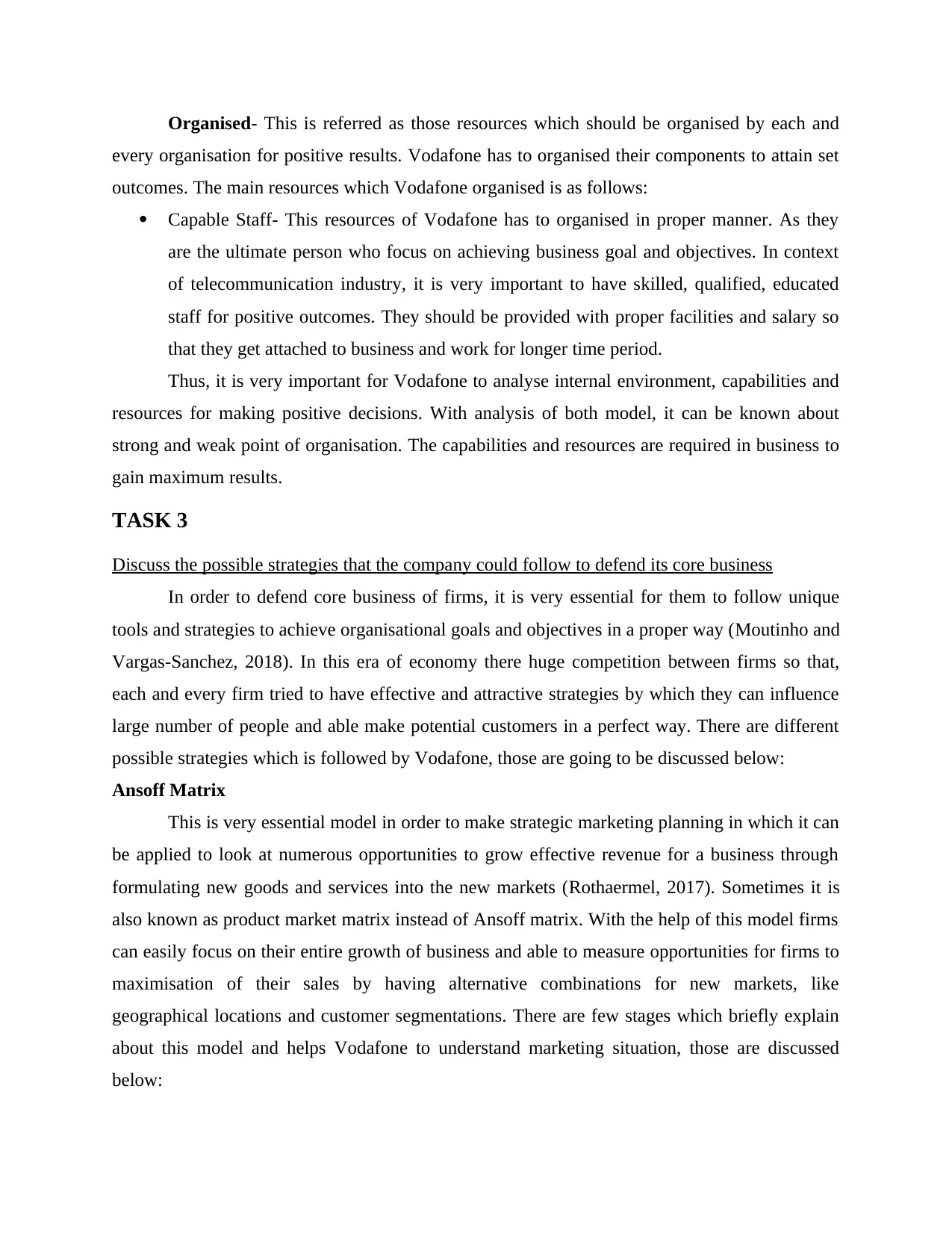
Organised- This is referred as those resources which should be organised by each and
every organisation for positive results. Vodafone has to organised their components to attain set
outcomes. The main resources which Vodafone organised is as follows:
Capable Staff- This resources of Vodafone has to organised in proper manner. As they
are the ultimate person who focus on achieving business goal and objectives. In context
of telecommunication industry, it is very important to have skilled, qualified, educated
staff for positive outcomes. They should be provided with proper facilities and salary so
that they get attached to business and work for longer time period.
Thus, it is very important for Vodafone to analyse internal environment, capabilities and
resources for making positive decisions. With analysis of both model, it can be known about
strong and weak point of organisation. The capabilities and resources are required in business to
gain maximum results.
TASK 3
Discuss the possible strategies that the company could follow to defend its core business
In order to defend core business of firms, it is very essential for them to follow unique
tools and strategies to achieve organisational goals and objectives in a proper way (Moutinho and
Vargas-Sanchez, 2018). In this era of economy there huge competition between firms so that,
each and every firm tried to have effective and attractive strategies by which they can influence
large number of people and able make potential customers in a perfect way. There are different
possible strategies which is followed by Vodafone, those are going to be discussed below:
Ansoff Matrix
This is very essential model in order to make strategic marketing planning in which it can
be applied to look at numerous opportunities to grow effective revenue for a business through
formulating new goods and services into the new markets (Rothaermel, 2017). Sometimes it is
also known as product market matrix instead of Ansoff matrix. With the help of this model firms
can easily focus on their entire growth of business and able to measure opportunities for firms to
maximisation of their sales by having alternative combinations for new markets, like
geographical locations and customer segmentations. There are few stages which briefly explain
about this model and helps Vodafone to understand marketing situation, those are discussed
below:
every organisation for positive results. Vodafone has to organised their components to attain set
outcomes. The main resources which Vodafone organised is as follows:
Capable Staff- This resources of Vodafone has to organised in proper manner. As they
are the ultimate person who focus on achieving business goal and objectives. In context
of telecommunication industry, it is very important to have skilled, qualified, educated
staff for positive outcomes. They should be provided with proper facilities and salary so
that they get attached to business and work for longer time period.
Thus, it is very important for Vodafone to analyse internal environment, capabilities and
resources for making positive decisions. With analysis of both model, it can be known about
strong and weak point of organisation. The capabilities and resources are required in business to
gain maximum results.
TASK 3
Discuss the possible strategies that the company could follow to defend its core business
In order to defend core business of firms, it is very essential for them to follow unique
tools and strategies to achieve organisational goals and objectives in a proper way (Moutinho and
Vargas-Sanchez, 2018). In this era of economy there huge competition between firms so that,
each and every firm tried to have effective and attractive strategies by which they can influence
large number of people and able make potential customers in a perfect way. There are different
possible strategies which is followed by Vodafone, those are going to be discussed below:
Ansoff Matrix
This is very essential model in order to make strategic marketing planning in which it can
be applied to look at numerous opportunities to grow effective revenue for a business through
formulating new goods and services into the new markets (Rothaermel, 2017). Sometimes it is
also known as product market matrix instead of Ansoff matrix. With the help of this model firms
can easily focus on their entire growth of business and able to measure opportunities for firms to
maximisation of their sales by having alternative combinations for new markets, like
geographical locations and customer segmentations. There are few stages which briefly explain
about this model and helps Vodafone to understand marketing situation, those are discussed
below:
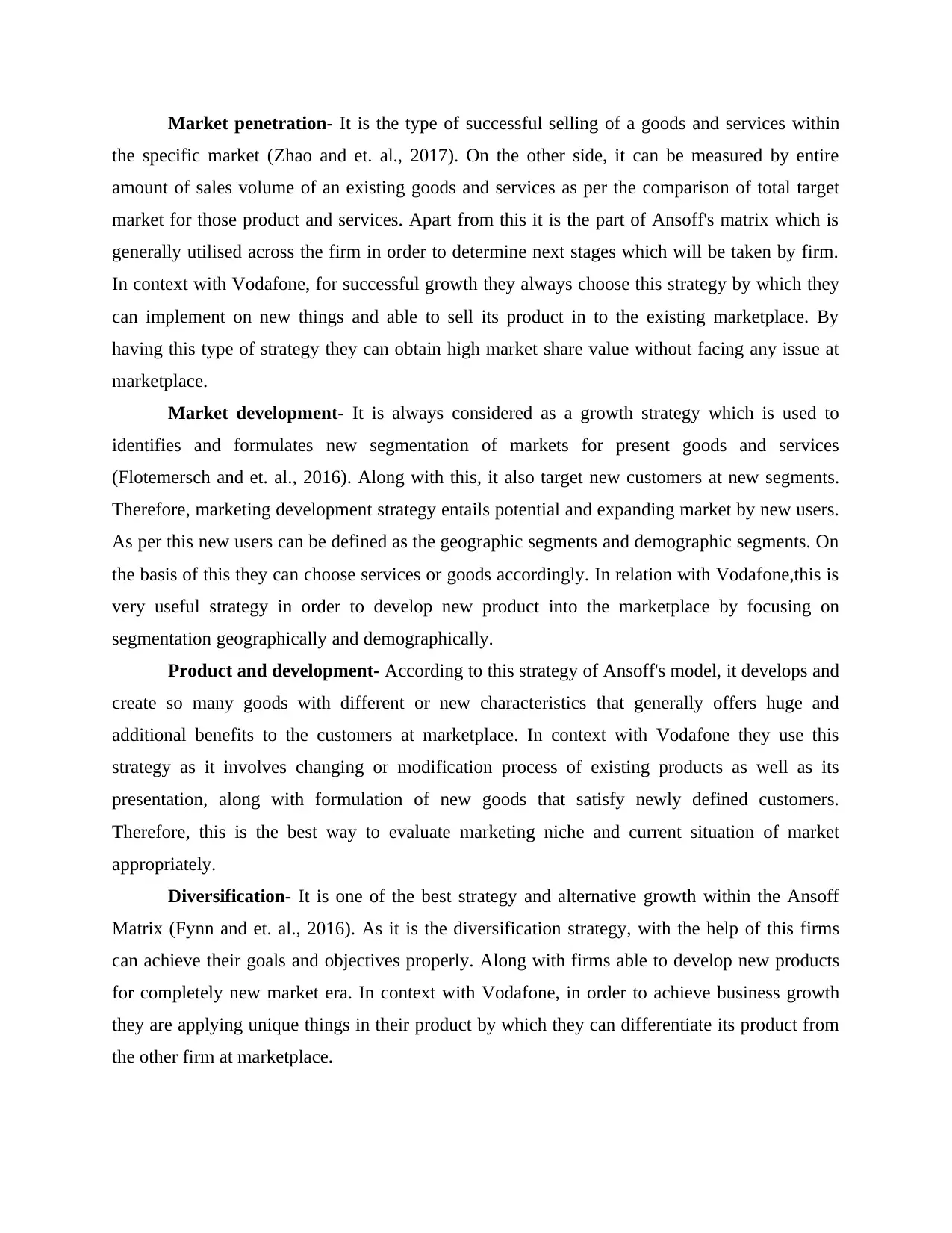
Market penetration- It is the type of successful selling of a goods and services within
the specific market (Zhao and et. al., 2017). On the other side, it can be measured by entire
amount of sales volume of an existing goods and services as per the comparison of total target
market for those product and services. Apart from this it is the part of Ansoff's matrix which is
generally utilised across the firm in order to determine next stages which will be taken by firm.
In context with Vodafone, for successful growth they always choose this strategy by which they
can implement on new things and able to sell its product in to the existing marketplace. By
having this type of strategy they can obtain high market share value without facing any issue at
marketplace.
Market development- It is always considered as a growth strategy which is used to
identifies and formulates new segmentation of markets for present goods and services
(Flotemersch and et. al., 2016). Along with this, it also target new customers at new segments.
Therefore, marketing development strategy entails potential and expanding market by new users.
As per this new users can be defined as the geographic segments and demographic segments. On
the basis of this they can choose services or goods accordingly. In relation with Vodafone,this is
very useful strategy in order to develop new product into the marketplace by focusing on
segmentation geographically and demographically.
Product and development- According to this strategy of Ansoff's model, it develops and
create so many goods with different or new characteristics that generally offers huge and
additional benefits to the customers at marketplace. In context with Vodafone they use this
strategy as it involves changing or modification process of existing products as well as its
presentation, along with formulation of new goods that satisfy newly defined customers.
Therefore, this is the best way to evaluate marketing niche and current situation of market
appropriately.
Diversification- It is one of the best strategy and alternative growth within the Ansoff
Matrix (Fynn and et. al., 2016). As it is the diversification strategy, with the help of this firms
can achieve their goals and objectives properly. Along with firms able to develop new products
for completely new market era. In context with Vodafone, in order to achieve business growth
they are applying unique things in their product by which they can differentiate its product from
the other firm at marketplace.
the specific market (Zhao and et. al., 2017). On the other side, it can be measured by entire
amount of sales volume of an existing goods and services as per the comparison of total target
market for those product and services. Apart from this it is the part of Ansoff's matrix which is
generally utilised across the firm in order to determine next stages which will be taken by firm.
In context with Vodafone, for successful growth they always choose this strategy by which they
can implement on new things and able to sell its product in to the existing marketplace. By
having this type of strategy they can obtain high market share value without facing any issue at
marketplace.
Market development- It is always considered as a growth strategy which is used to
identifies and formulates new segmentation of markets for present goods and services
(Flotemersch and et. al., 2016). Along with this, it also target new customers at new segments.
Therefore, marketing development strategy entails potential and expanding market by new users.
As per this new users can be defined as the geographic segments and demographic segments. On
the basis of this they can choose services or goods accordingly. In relation with Vodafone,this is
very useful strategy in order to develop new product into the marketplace by focusing on
segmentation geographically and demographically.
Product and development- According to this strategy of Ansoff's model, it develops and
create so many goods with different or new characteristics that generally offers huge and
additional benefits to the customers at marketplace. In context with Vodafone they use this
strategy as it involves changing or modification process of existing products as well as its
presentation, along with formulation of new goods that satisfy newly defined customers.
Therefore, this is the best way to evaluate marketing niche and current situation of market
appropriately.
Diversification- It is one of the best strategy and alternative growth within the Ansoff
Matrix (Fynn and et. al., 2016). As it is the diversification strategy, with the help of this firms
can achieve their goals and objectives properly. Along with firms able to develop new products
for completely new market era. In context with Vodafone, in order to achieve business growth
they are applying unique things in their product by which they can differentiate its product from
the other firm at marketplace.
⊘ This is a preview!⊘
Do you want full access?
Subscribe today to unlock all pages.

Trusted by 1+ million students worldwide
1 out of 18
Related Documents
Your All-in-One AI-Powered Toolkit for Academic Success.
+13062052269
info@desklib.com
Available 24*7 on WhatsApp / Email
![[object Object]](/_next/static/media/star-bottom.7253800d.svg)
Unlock your academic potential
Copyright © 2020–2025 A2Z Services. All Rights Reserved. Developed and managed by ZUCOL.





